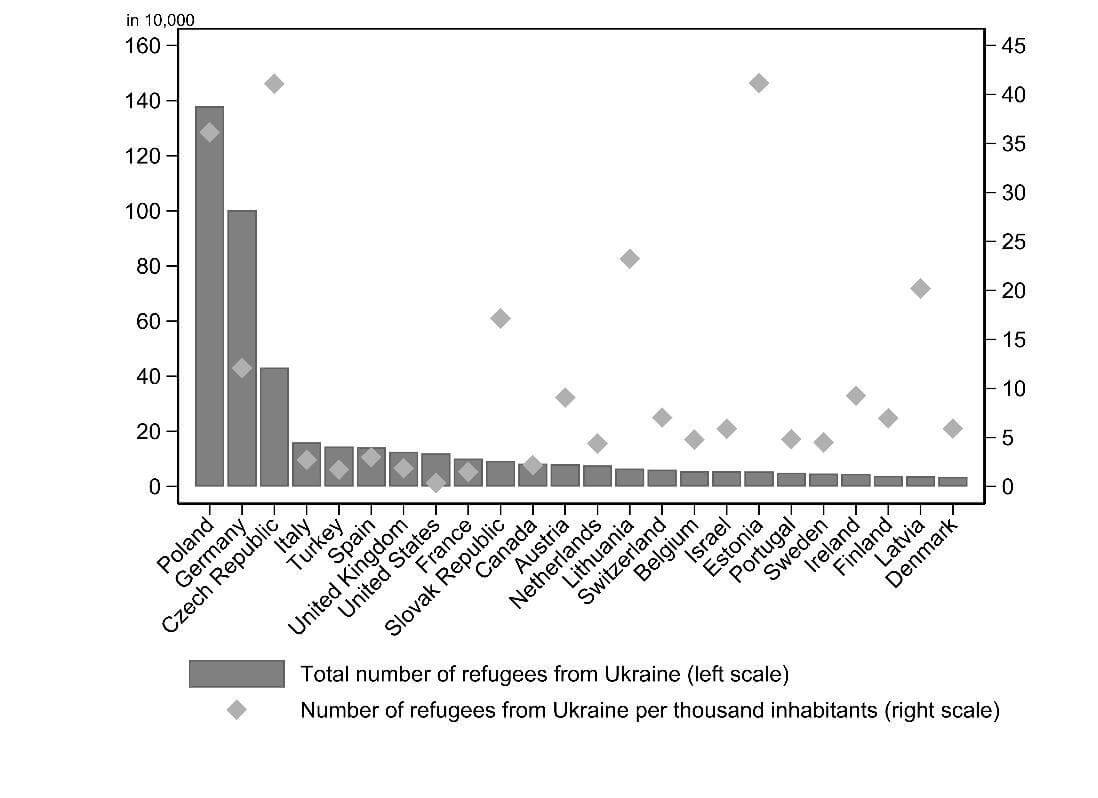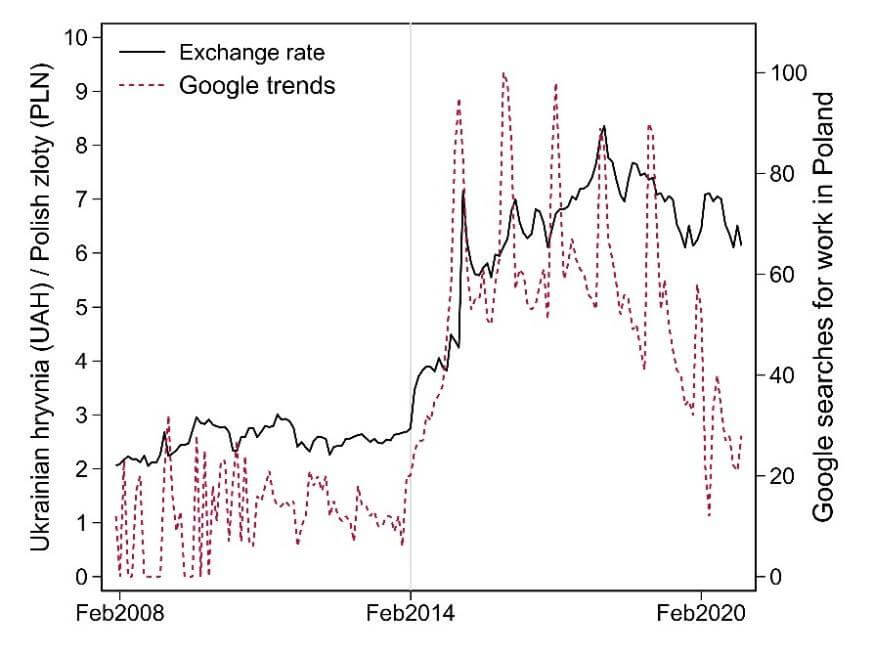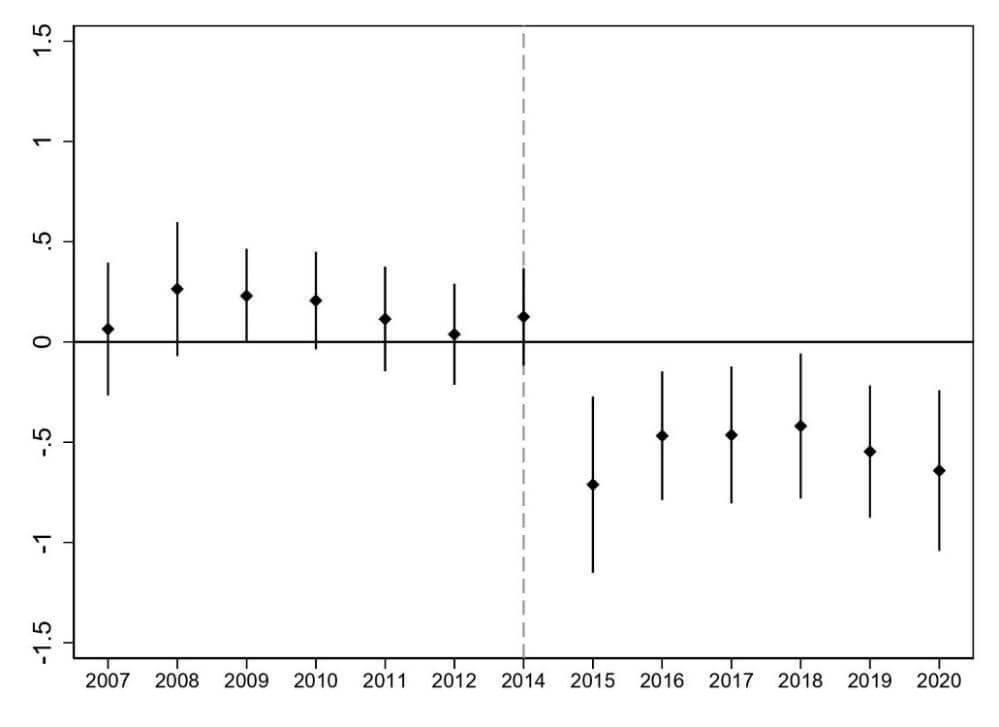Russia’s attacks against Ukraine have led to massive and unexpected migratory movements. The first conflict-induced migration surge followed the annexation of Crimea in 2014. More recently, Russia’s full-scale invasion of Ukraine in February 2022 led to the displacement of more than 8 million people. The subsequent decision to invoke the Temporary Protection Directive in the European Union resulted in unprecedented free access for Ukrainian refugees to the labor markets of host countries.
The countries most affected per capita by the inflow of Ukrainian refugees are mainly post-communist countries such as the Czech Republic, Estonia, Latvia, Lithuania or Poland (Figure 1). These countries are not established immigration countries. On the contrary, since the fall of the Iron Curtain, they have experienced massive emigration, especially of highly educated citizens. The sudden inflow of Ukrainians could potentially increase competition in their labor markets, leading to an increase in emigration. However, an examination of the effects of the inflow of Ukrainians to Poland following Russia’s aggression in 2014 suggests that in a post-communist country with a surplus of highly educated citizens, an immigration shock can lead to a decrease in emigration.
Figure 1. Refugees from Ukraine in OECD countries as of mid-September 2022
To examine the long-term effect of war-induced immigration on migration patterns of the local population in the host communities, the study focuses on the inflow of temporary workers from Ukraine to Poland after 2014. The annexation of Crimea and the ongoing conflict in the Donbass region have led to a destabilization of the Ukrainian economy, forcing many Ukrainians to look for work abroad. The sudden increase in interest in working in Poland, illustrated by the sudden increase in Google searches in Ukraine for ‘work in Poland’ (Ukrainian: ‘робота в Польщі’), mirrors the sharp devaluation of the Ukrainian hryvnia in the wake of Russia’s aggression in 2014 (Figure 2).
Figure 2. Exchange rate of Polish zloty to Ukrainian hryvnia and Google searches for ‘work in Poland’
At the time of the inflow of Ukrainians, Poland was experiencing a massive problem with the emigration of well-educated citizens. Between 2004 and 2014, about two million Poles, mostly young and educated, left the country. The reason: After the Cold War, the number of university graduates increased massively as the Polish population hoped for better career opportunities. However, the Polish labor market quickly became saturated, and the young, highly educated Poles had to seek employment abroad.
This trend could be further intensified by a potential increase in competition amid the massive inflow of Ukrainian workers. However, instead of an increase in emigration, Poland has seen a decrease in emigration after 2014, especially among highly educated citizens. In fact, after the inflow of temporary workers from Ukraine, Poland had a positive permanent migration balance for the first time since the fall of the Iron Curtain.
Establishing a causal relationship between the inflow of Ukrainians and changes in local migration patterns in Poland is not straightforward, as the location of Ukrainians within Poland was not random, but correlated with the characteristics of local labor markets. For example, the local share of Ukrainians is correlated with lower local unemployment and higher wages. However, the existence of the Ukrainian ethnic minority in Poland allows for the estimation of a causal effect.
Most Ukrainians living in Poland were resettled to the Soviet Union after World War II. However, about 140,000 Ukrainians were forcibly resettled by the Polish People’s Army in 1947 to northern and western Poland, as far away as possible from their historic settlements in what is now southeastern Poland. The existence of the Ukrainian network, which emerged after the forced resettlement and survived the suppression of the Ukrainian national identity, allows us to isolate the causal effect for Ukrainians whose location decision was influenced by the existence of this Ukrainian ethnic network in Poland. Thus, while the correlation between the share of Ukrainians and local migration patterns cannot be interpreted causally, as it is influenced by the characteristics of local labor markets (e.g., Ukrainian workers go to places with higher wages, and higher wages also reduce the incentive to emigrate), I estimate a causal effect driven by Ukrainian workers whose location decision within Poland was influenced by their historical network.
The results show that the inflow of Ukrainians into local labor markets reduces out-migration. On average, the local inflow of about 1,000 Ukrainian workers reduces emigration by about 5 inhabitants, and the magnitude of this effect appears to be stable over time (Figure 3). Overall, about 30% of the decline in emigration from Poland for permanent stay between 2013 and 2019 can be attributed to the inflow of Ukrainian workers.
Figure 3. Impact of the local inflow of Ukrainians on emigration
Further results show a decrease in internal out-migration and in internal in-migration. The latter suggests that the local inflow of Ukrainians crowds out internal in-migration, i.e. in-migration from other Polish counties. However, there is no evidence of crowding out of international in-migration.
The overall magnitude of the effects and supplementary evidence on mechanisms point to an enlargement of local labor markets with greater exposure to Ukrainian workers. In addition, descriptive evidence indicates complementarities between Ukrainian workers and Polish emigrants. While Ukrainian workers were not necessarily low-skilled, they mostly performed low- and medium-skilled jobs and thus occupied positions that were complementary to high-skilled jobs. This suggests that highly educated Poles, potential emigrants, were absorbed by the enlarged local labor markets by filling positions complementary to those held by Ukrainians.
Taken together, the findings show that in Poland, a post-communist country with an abundance of highly educated citizens, an immigration shock mitigated the emigration from hosting communities. This points to the potential benefits of open borders and enabling access to the labor market, even for countries without established immigration structures.
This article is a short summary of the paper “Migration Response to an Immigration Shock: Evidence from Russia’s Aggression against Ukraine” published by the author of this article as Ruhr Economics Papers #1093. The paper, along with all data sources underlying the empirical analysis and figures, is available here.
Attention
The author doesn`t work for, consult to, own shares in or receive funding from any company or organization that would benefit from this article, and have no relevant affiliations





